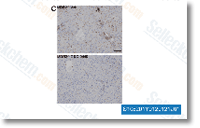Analysis with the mTOR pathway unveiled that cells expressing DEK NUP214 have higher amounts of both complete mTOR protein and mTOR protein phosphory lated at Ser2448. To determine the effect of the improved mTOR amounts about the activity with the two mTOR complexes, we analyzed the phosphorylation status of their downstream targets. The p70 S6 kinase is often a substrate for mTORC1, activated by phosphorylation by mTOR at Thr389. Concurrent with mTORC1 activation, we observed an increase in the level of phos phorylated p70S6K protein. Nevertheless, the mTORC2 mediated phosphorylation of Akt at Ser473 was not impacted through the expression of DEK NUP214, suggesting that the increased levels of mTOR in this instance largely leads selleckchem to elevated mTORC1 exercise. To characterize the mTOR maximize, we analyzed the transcription from the mTOR gene by actual time PCR.
This was unaffected by selleck chemicals DEK NUP214, demonstrat ing that the maximize in mTOR expression takes place to the submit transcriptional degree. We proceeded to examine the upstream regulators of mTORC1. Even so, these didn’t show altered activation as determined by western blot towards phosphorylated AMPK and GSK3 at the same time since the two activating phosphorylations of Akt at Thr308 and Ser473. The enhanced phosphorylation of Akt at Thr308 during the 2nd DEK NUP214 clone was not seen from the other DEK NUP214 clones and was therefore attributed to mechanisms apart from the expression of your fusion protein. In conclusion, our protein expression information suggests that expression of the DEK NUP214 fusion gene prospects to larger protein levels of mTOR and elevated signaling as a result of the mTORC1 pathway. DEK NUP214 increases protein synthesis To find out the practical value of the elevated mTOR signaling, we proceeded to examine protein transla tion.
We performed a international translation assay where the incorporation of radioactively labeled amino acids into newly synthesized proteins displays the fee of translation. The results demonstrate that one particular day immediately after seeding in fresh culture medium, U937 cells  expressing DEK NUP214 and control cells both display high translation prices. Nonetheless, three days soon after seeding, the translation costs have declined from their maxima as well as impact of DEK NUP214 be comes clear. The cells expressing DEK NUP214 then had a 68% greater protein synthesis compared to the control cells. This demonstrates that DEK NUP214 sustains a larger translation rate, in concordance with improved pro translational signaling. DEK NUP214 induces a metabolic shift Additionally to its position in protein translation, mTOR also regulates glucose metabolic process. While in the balance between aerobic and anaerobic catabolism, mTORC1 promotes the more energy efficient oxidative phosphorylation in excess of glycolysis.
expressing DEK NUP214 and control cells both display high translation prices. Nonetheless, three days soon after seeding, the translation costs have declined from their maxima as well as impact of DEK NUP214 be comes clear. The cells expressing DEK NUP214 then had a 68% greater protein synthesis compared to the control cells. This demonstrates that DEK NUP214 sustains a larger translation rate, in concordance with improved pro translational signaling. DEK NUP214 induces a metabolic shift Additionally to its position in protein translation, mTOR also regulates glucose metabolic process. While in the balance between aerobic and anaerobic catabolism, mTORC1 promotes the more energy efficient oxidative phosphorylation in excess of glycolysis.
AMPK Signal
AMPK is formed by α, β, and γ subunits
